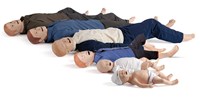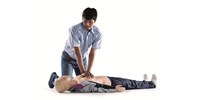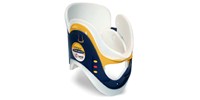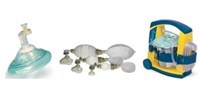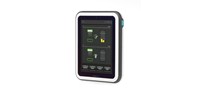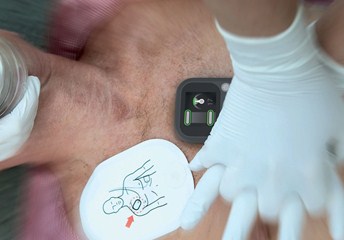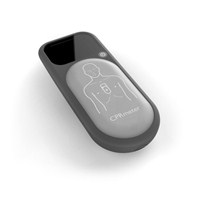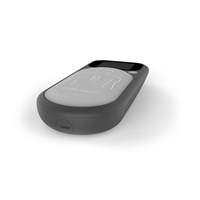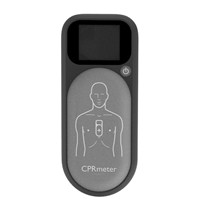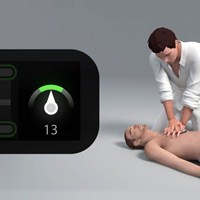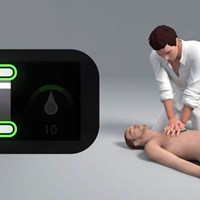Consistent Quality
The consensus is clear, high-quality CPR has been shown to save lives.1,2 But, how do you know if your teams are consistently delivering high-quality compressions? The CPRmeter 2 is a simple tool you can use to ensure high-quality compressions are delivered from all the providers on scene.3,4 The CPRmeter 2 provides real-time measured feedback on depth, rate and release of CPR, while also enabling providers to self-evaluate their performance with event statistics on the spot.
Get instant feedback on your quality
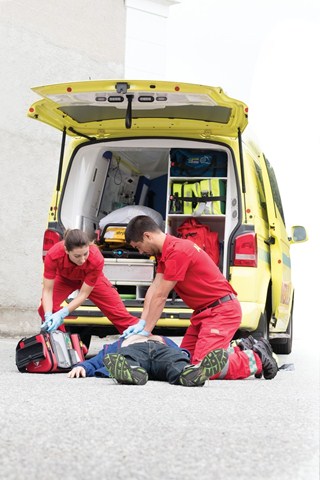 |
Quality Improvement for First Response ProvidersResponse systems to cardiac arrest vary, but we know that the sooner high quality CPR can be initiated, the better chances for positive patient outcomes.5 Equipping front line teams with the CPRmeter 2 can help ensure high quality throughout the resuscitation event, while complementing ongoing improvement initiatives with objective feedback.3,4 |
Quick and easy debriefing
Review key performance statistics of delivered compressions with one touch after the event. Resuscitation response scenes tend to be hectic with dispersing responders. Having instant access to objective key performance metrics can lead to quick feedback and debriefing, which has been shown to improve performance and outcomes.6,7,8
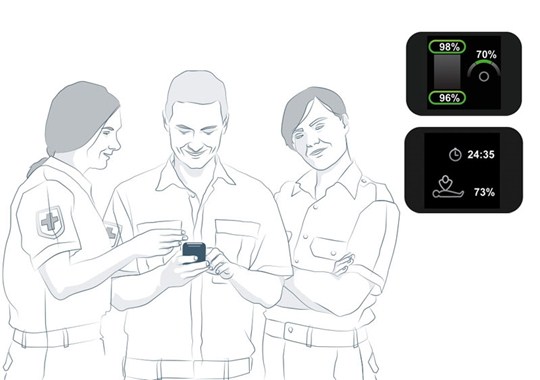 |
New and impoved features
 |
 |
 |
| New ergonomic design | Larger and brighter display | Simple cleaning and disinfection methods |
 |
 |
 |
| Longer run time with AAA battery | Low cost of ownership | Fast wireless software updates |
FAQ
| How does the CPRmeter 2 work? |
|
CPRmeter 2 has two embedded sensors: one measuring acceleration and another measuring force. A sophisticated microprocessor continuously measures both of these parameters during each compression, and special algorithms convert the collected data into meaningful information. The accelerometer measures the depth and rate of chest wall movement during each compression and converts it into distance travelled. The force sensor measures the force applied during CPR and is used for several purposes, the most important being to detect that pressure is not fully released between compressions i.e. provide feedback if the responder is leaning during CPR. CPRmeter 2 utilizes similar Q-CPR technology found in the Philips MRx, Philips XL+ and Philips FR3 defibrillators. |
| Can CPRmeter 2 be used on infants or children? |
| CPRmeter 2 is currently designed to be used on children greater than 8 years old or 25kg (55lbs) in weight. |
| Can CPRmeter 2 remain applied to the patient’s chest during defibrillation? |
| When a shock is required the CPRmeter 2 can remain applied to the patient's chest but compressions should be stopped, hands removed from the CPRmeter 2 and remain clear of all patient contact during defibrillation or when otherwise required, in accordance with a proper defibrillation protocol. |
| What should I do if I am using CPRmeter 2 with a manikin which gives feedback? |
| You should switch off the feedback given from the manikin. The CPRmeter 2 is a medical device which has been designed to provide the rescuer with CPR guidance for use in a wide range of patients with a range of complex chest properties. CPR manikins tend to have a simplified mechanical model of a chest, which are suitable for training of users in performing CPR. These two models therefore tend to have different measurement technologies and tolerances making it difficult to compare and follow both sets of feedback provided. |
| Can I use CPRmeter 2 during transport of the patient in an ambulance? |
| CPRmeter 2 is not intended for use in a moving environment, such as an ambulance. If used during patient transport, CPRmeter 2 may provide inaccurate feedback. If CPR is indicated in a moving environment, do not rely on CPRmeter 2 depth feedback during such conditions. It is not necessary to remove the device from the patient. |
| Can the CPRmeter 2 be used in rain and other adverse weather conditions? |
|
Yes, the CPRmeter 2 has an IP 55 rating. Protected from limited dust ingress. Protected from pressure water jets from any direction. |
| How long will the Battery last? |
| CPRmeter 2 continuously monitors the power of its 2 AAA batteries. The low battery indicator will be shown during a CPR event if the remaining power is less than that required for an entire CPR event. The battery should last for a minimum of 10 episodes of 30 minutes continuous CPR. If CPRmeter 2 remains in standby mode then the battery should last 2 years and last for 2 30 minute CPR events. We recommend use of high quality alkaline batteries for use with the CPRmeter 2. |
| Can I view the Q-CPR Quick Review event statistics after CPRmeter 2 has been switched off? |
| The CPR event statistics are stored when CPRmeter 2 is turned off. When turned on again, the statistics from the stored CPR event can be reviewed. When CPRmeter 2 is used in a new CPR event, the preceding event’s statistics are removed from the Quick Review and the new event’s statistics are shown in Q-CPR Quick Review. |
| What is Q-CPR? |
| Q-CPR is a trademarked technology platform developed by Laerdal to help train providers deliver guideline quality CPR in real-life emergencies. This technology offers objective measurement and corrective feedback on essential CPR parameters, as well as parameter logging for subsequent debriefing or analysis. |
| How often should the patient adhesive be replaced? |
| The Patient Adhesive should be replaced after clinical use, or every two years. |
References
- Steven L. Kronick, Michael C. Kurz, et al Part 4: Systems of Care and Continuous Quality Improvement 2015 American Heart Association Guidelines Update for Cardiopulmonary Resuscitation and Emergency Cardiovascular Care. Circulation. 2015;132:S397-S413
- Nichol G, Thomas E, Callaway CW, Hedges J, Powell JL, Aufderheide TP, Rea T, Lowe R, Brown T, Dreyer J, Davis D, Idris A, Stiell I; Resuscitation Outcomes Consortium Investigators. Regional variation in out-of-hospital cardiac arrest incidence and outcome [published correction appears in JAMA. 2008;300:1763]. JAMA. 2008;300:1423–1431.
- Buleon, J. Parienti, J-J, Halbout, L., et. al.(2013) AJEM; Improvement in chest compression quality using feedback device (CPRmeter):a simulation randomized crossover study
- Skorning, M., Beckers, S.K., Brokmann, J.C., et al. (2010), Resuscitation; New Visual Feedback Device Improves Performance of Chest Compressions by Professionals in Simulated Cardiac Arrest”
- Link MS, Atkins DL, Passman RS, Halperin HR, Samson RA, White RD, Cudnik MT, Berg MD, Kudenchuk PJ, Kerber RE. Part 6: electrical therapies: automated external defibrillators, defibrillation, cardioversion, and pacing: 2010 American Heart Association Guidelines for Cardiopulmonary Resuscitation and Emergency Cardiovascular Care. Circulation. 2010;122(suppl 3):S706 –S719.
- Edelson, D. P., B. Litzinger, V. Arora, D. Walsh, S. Kim, D. S. Lauderdale, T. L. Vanden Hoek, L. B. Becker, and B. S. Abella. 2008. Improving inhospital cardiac arrest process and outcomes with performance debriefing. Archives of Internal Medicine 168(10):1063-1069.
- Zebuhr C, Sutton RM, Morrison W, Niles D, Boyle L, Nishisaki A, Meaney P, Leffelman J, Berg RA, Nadkarni VM. Evaluation of quantitative debriefing after pediatric cardiac arrest. Resuscitation. 2012;83:1124–1128.
- Dine CJ, Gersh RE, Leary M, Riegel BJ, Bellini LM, Abella BS. Improving cardiopulmonary resuscitation quality and resuscitation training by combining audiovisual feedback and debriefing. Crit Care Med. 2008

 USA
USA
